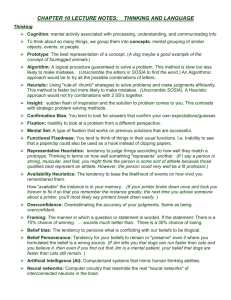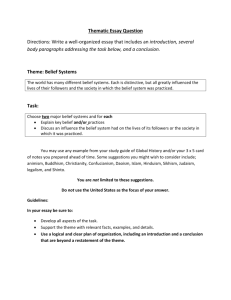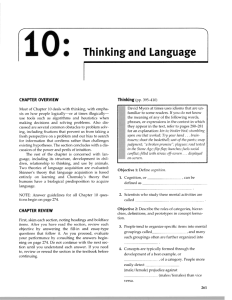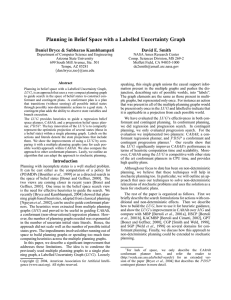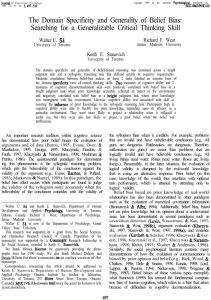Thinking is Cognition
advertisement
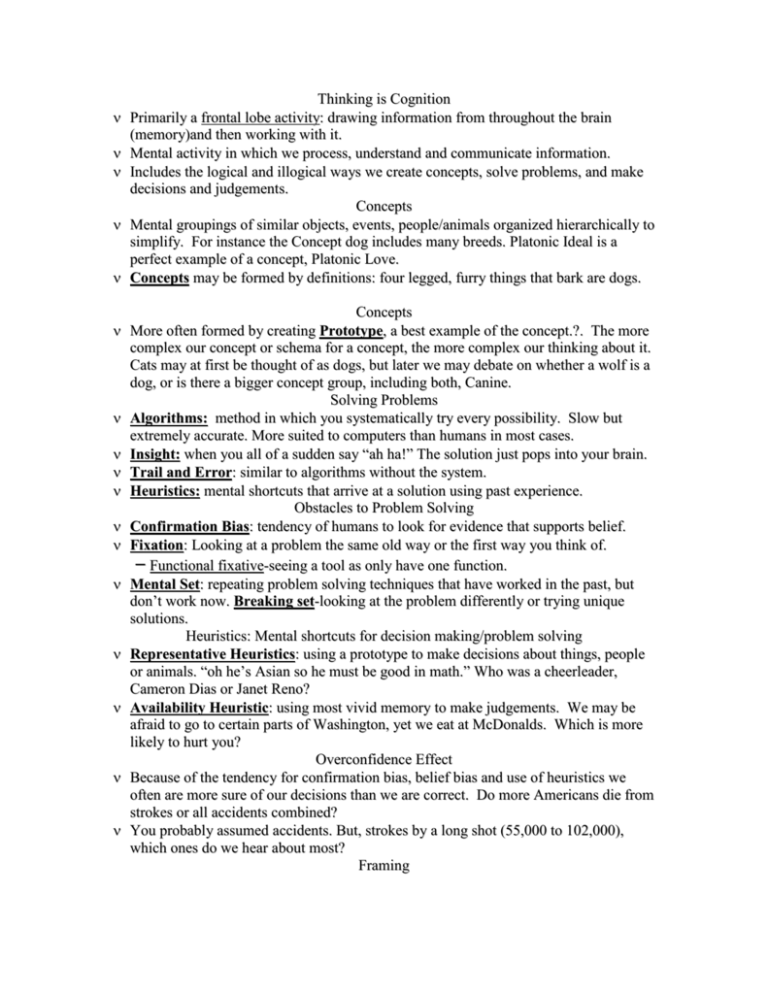
Thinking is Cognition Primarily a frontal lobe activity: drawing information from throughout the brain (memory)and then working with it. Mental activity in which we process, understand and communicate information. Includes the logical and illogical ways we create concepts, solve problems, and make decisions and judgements. Concepts Mental groupings of similar objects, events, people/animals organized hierarchically to simplify. For instance the Concept dog includes many breeds. Platonic Ideal is a perfect example of a concept, Platonic Love. Concepts may be formed by definitions: four legged, furry things that bark are dogs. Concepts More often formed by creating Prototype, a best example of the concept.?. The more complex our concept or schema for a concept, the more complex our thinking about it. Cats may at first be thought of as dogs, but later we may debate on whether a wolf is a dog, or is there a bigger concept group, including both, Canine. Solving Problems Algorithms: method in which you systematically try every possibility. Slow but extremely accurate. More suited to computers than humans in most cases. Insight: when you all of a sudden say “ah ha!” The solution just pops into your brain. Trail and Error: similar to algorithms without the system. Heuristics: mental shortcuts that arrive at a solution using past experience. Obstacles to Problem Solving Confirmation Bias: tendency of humans to look for evidence that supports belief. Fixation: Looking at a problem the same old way or the first way you think of. – Functional fixative-seeing a tool as only have one function. Mental Set: repeating problem solving techniques that have worked in the past, but don’t work now. Breaking set-looking at the problem differently or trying unique solutions. Heuristics: Mental shortcuts for decision making/problem solving Representative Heuristics: using a prototype to make decisions about things, people or animals. “oh he’s Asian so he must be good in math.” Who was a cheerleader, Cameron Dias or Janet Reno? Availability Heuristic: using most vivid memory to make judgements. We may be afraid to go to certain parts of Washington, yet we eat at McDonalds. Which is more likely to hurt you? Overconfidence Effect Because of the tendency for confirmation bias, belief bias and use of heuristics we often are more sure of our decisions than we are correct. Do more Americans die from strokes or all accidents combined? You probably assumed accidents. But, strokes by a long shot (55,000 to 102,000), which ones do we hear about most? Framing The way a question is asked will affect our decisions/judgements. In which case would you by a ticket to a Broadway show? 1) Go to the theatre and find you’ve lost a $75 dollar ticket. 2) Go to the theatre and find you lost $75 dollars from your wallet? Belief Bias We more easily see as logical support for currently held belief and see the illogic of arguments that contradict or belief. Belief perseverance: it takes overwhelming evidence to “break” us of a belief. Can be very damaging: a student who doesn’t do well in 1st and 2nd grade may feel inadequate the rest of their academic life. Do teacher “slot you” based on nonacademic criteria? Language Spoken, written and gestured words and how they are combined to convey meaning. Structure Phonemes: are the basic sounds of a language. English has about 40. Phonemes are distinct to languages and you lose the ability to perceive or say some in infancy, if they are not part of your language. Structure Morphemes are the smallest unit of language that conveys meaning. May or may not be a word. I is a word, but -ing isn’t but they both convey a meaning. So, ed, s, un, a, are all morphemes. Structure The grammatical rules of order and organization of a language is called the Syntax. The meaning of a sentence is the semantics. A sentence may be correct in either and not in the other. Dialects may be correct but different in syntax: “I ain’t got none” conveys meaning, even though it violates rules of grammar. Stages of Speech Development Babbling: all phonemes are babbled by all babies. At 10 months you begin to lose your ability say or perceive some phonemes. One word stage: usually of things that move or can be played with: ball, truck, not table or chair. Stages of Speech Development Two word: telegraphic speech because it sound like a telegram, usually nouns and verbs in the correct order. Mommy go. Want truck. There is no three word stage, people go to developing complex sentences. Grammatical errors tend to be one of generalization. Mouses, not mice. Stages of Speech Development Language Acquisition Device: Noam Chomsky’s idea that the brain is hardwired for grammar. That the words are learned (Skinnarian), but that the language skill is the same for all languages, including sign languages. Like filling up a glass, the glass is inborn, water learned. All languages have nouns, verb, adj., adv. articles, etc. implying a universal “brain thing”. The deaf will develop there own language with above, even when not taught. Stages of Speech Development Critical period: there is a critical period when language must be developed if it ever is to be learned fluently. Certainly by 13 y.o. 2nd languages learned earliest are learned best. After the critical period, they are even stored in a different part of the brain. Rarely are they spoken without an accent after Critical period. Language and Thinking Linguistic Relativity: the belief that concepts come with the language. If you do not have the vocabulary for a concept can you understand it? If you didn’t have a past tense, could you think about the past? Bilingual people score higher on IQ tests, is that because they have more concepts to work with? Eskimos have more words for snow, can they think more complexly about it. Language Words don’t have meaning beyond what is agreed upon. Words are flexible and can take on new meaning. We assume everything has a name, that is, it is intrinsic to the object. . Language Enables us to talk about things not in the moment. Language is creative, we generate sentences rather than repeat them. Most sentences are original and the amount of combinations, infinite. Language and Thinking Thinking without language: how much can you think without words. If I ask you which way you bedroom door opened, you would visualize it without thinking in works. You could probably solve the Hobbits and Orcs problem better using manipulative rather than language. So we can think visually or with language as symbols of what we see. Constructs are a different thing.
